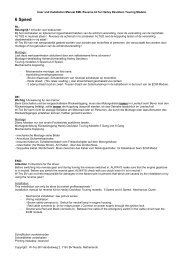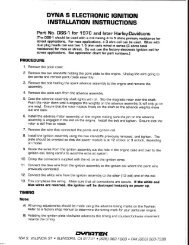Mounting Instructions Electronic Tachometer with adjustable Ratio ...
Mounting Instructions Electronic Tachometer with adjustable Ratio ...
Mounting Instructions Electronic Tachometer with adjustable Ratio ...
Create successful ePaper yourself
Turn your PDF publications into a flip-book with our unique Google optimized e-Paper software.
<strong>Mounting</strong> <strong>Instructions</strong> <strong>Electronic</strong> <strong>Tachometer</strong> <strong>with</strong> <strong>adjustable</strong> <strong>Ratio</strong> ∅ 48 mm<br />
Dear Customer,<br />
you made a good selection buying this new MMB ® device.<br />
The product should be installed by a person specialising in the installation of such devices.<br />
1. Safety <strong>Instructions</strong><br />
To install the electric cables, use existing cable ducts and looms, but do not run the cables parallel to<br />
ignition cables or parallel to cables leading to powerful consumers. Secure the cables <strong>with</strong> cable<br />
binders or adhesive tape.<br />
When you install the electric cables please also note:<br />
- Do not run the cables over moving parts.<br />
- If the cables have to be run through drilled holes, protect the cables using grommets or rubber<br />
bushings etc.<br />
- Ensure that the cables are not exposed to any tensile, compressive or shear forces.<br />
- Use only a cable stripper to strip the cables. Adjust the cable stripper so that the individual strands<br />
are not damaged or cut off.<br />
- New connections should be made only by using commercial crimp connectors.<br />
- Crimped connections should be made only by using a cable crimping pliers.<br />
- Insulate exposed leads in such a way that short circuits cannot occur.<br />
- Caution: Risk of short circuit through faulty junctions or damaged cables.<br />
Please check all cables and connections for short circuits after you have finished the installation. Short<br />
circuits in the electrical system can cause cable fires, battery explosions and damages to other<br />
electronic systems. Incorrect connections can lead to short circuits.<br />
Use suitable tools for building-in the device and note the safety instructions of the tool manufacturers.<br />
2. General<br />
This electronic tachometer fits to almost motorcycles, because its ratio can be adjusted and it can be<br />
used for positive ignition pulses as well as for negative ignition pulses.<br />
A 12 V on-board voltage is required; the negative pole of the battery has to be grounded.<br />
The signal can be drawn either<br />
- from the ignition coil (breaker side or ignition electronic circuit side) or<br />
- from ignition electronic side <strong>with</strong> special electronic tachometer connector.<br />
Depending on the type of the tachometer, it can be mounted into a instrument panel (a recess of<br />
D=48.5 + 0.5 mm in the instrument panel is required) or into a suitable gauge mount. Gauges <strong>with</strong><br />
retainer bracket can be mount on the handle bar <strong>with</strong> a suitable clamp. The gauge has to be mounted<br />
in a vibration-damped way.<br />
3. Description of the tachometer<br />
As the tachometer has two different possibilities of connecting, it can be used for positive ignition<br />
pulses (transistorized ignition, single fire, dual fire ignition) as well as for negative ignition pulses (CDI<br />
ignition).<br />
Depending on the number of pulses your ignition provides per revolution, it is possible to adjust the<br />
tachometer to different ratios:<br />
i= 1:2 (1 pulse every second revolution) – for example Harley Davidson Single fire<br />
i= 1:1 (1 pulse every revolution) – the most common ratio<br />
i= 2:1 (2 pulses every revolution)<br />
i= 3:1 (3 pulses every revolution)<br />
The ratio can be set <strong>with</strong> the 2 dip-switches, situated on the bottom of the housing.<br />
Pulsotronic GmbH & Co. KG<br />
Division MMB Messtechnik<br />
Neue Schichtstraße 14b<br />
1<br />
D-09366 Niederdorf<br />
Call: +49 (37296) 930 250 Fax: +49 (37296) 930 258<br />
info@mmb-messtechnik.de www.mmb-messtechnik.de 75200075000 2609
Switch position<br />
ratio 1 ON 2 ON<br />
i=1:2<br />
i=1:1<br />
<br />
i=2:1<br />
<br />
i=3:1 <br />
factory default: i=1:1<br />
4. Electrical Connection<br />
Caution: Before starting the electrical installation clamp the battery to disconnect it. Please observe<br />
the above mentioned rules of safety.<br />
Connect the gauge according to the wiring diagram:<br />
plug no. 1 or orange wire – illumination +12 V DC<br />
plug no. 2 or red wire – on-board voltage +12V DC<br />
plug no. 3 or black wire – ground<br />
The other two plugs or wires are for the input pulse. Only one of these connection is used:<br />
plug no. 4 or green wire for a positive input pulse or<br />
plug no. 5 or white wire for a negative input pulse<br />
The plug that is not needed remains idle, respectively the unused wire has to be isolated.<br />
wiring diagram<br />
dip Switch<br />
orange<br />
red<br />
+ 12VDC-illumination<br />
+12VDC-ignition switch<br />
ON<br />
1 2<br />
1<br />
2<br />
3<br />
4<br />
5<br />
green<br />
white<br />
positive input pulse<br />
negative input pulse<br />
black<br />
ground<br />
ON<br />
ON<br />
ON<br />
ON<br />
1<br />
2<br />
1 2 1 2<br />
1 2<br />
i= 1:2<br />
i= 1:1<br />
i= 2:1<br />
i= 3:1<br />
Pulsotronic GmbH & Co. KG<br />
Division MMB Messtechnik<br />
Neue Schichtstraße 14b<br />
2<br />
D-09366 Niederdorf<br />
Call: +49 (37296) 930 250 Fax: +49 (37296) 930 258<br />
info@mmb-messtechnik.de www.mmb-messtechnik.de 75200075000 2609
If you do not know whether your ignition provides positive or negative pulses, please proceed as<br />
follows:<br />
- Leave dip switches on ratio i=1:1 (factory default)<br />
- Connect plug no. 4 or green wire to the negative terminal of one of the ignition coils (or if available,<br />
connect it <strong>with</strong> special tachometer connection on ignition box)<br />
- Now connect the battery to the vehicle. Every time you turn on the ignition, the tachometer will do<br />
an automatic self-test. During this self-test the pointer moves over the whole scale range.<br />
- Start the engine (idling speed is enough).<br />
- After starting the engine the pointer should move, means the tachometer should indicate<br />
something. In that case, please isolated the white wire (or plug no. 5 remains idle) and go on <strong>with</strong><br />
point 5 “Adjustment of the <strong>Tachometer</strong>”.<br />
- If there is no indication of any revolution (pointer does not move) after starting the engine, please<br />
switch off the engine and disconnect the battery again.<br />
- Disconnect plug no. 4 / green wire and use plug no. 5 / white wire instead. Isolate the green wire<br />
(or plug no. 4 remains idle).<br />
Connect the battery again to the vehicle, before starting it.<br />
5. Adjustment of the <strong>Tachometer</strong><br />
After connecting the battery to the vehicle and starting the engine, the pointer must move . Please size<br />
up the indicated idling speed. If the read out revolutions are correct, then there is no adjustment<br />
necessary.<br />
If the tachometer does not indicate the correct revolutions, the gauge has to be adjusted. The ignition<br />
has to be switched off during the adjustment:<br />
- if only the half of the correct revolutions is indicated – set dip switches to i=1:2<br />
- if the tachometer indicates twice as much – set dip switches to i=2:1<br />
- if the tachometer indicates three times as much – set dip switches to i=3:1<br />
6. Technical Details<br />
rated voltage…………………..…12V DC, the negative pole of the battery has to be grounded<br />
operating voltage…………….….10.8-15 V<br />
current consumption……………max. 150 mA <strong>with</strong>out illumination, approx. 70 mA illumination<br />
operating temperature………….-20 - +80 °C<br />
dimensions<br />
diameter………………...48 mm<br />
instrument height………85 mm <strong>with</strong> cap<br />
weight…………………………….100g – 150g; depends on type<br />
pulse input……………………….positive or negative pulse input<br />
from TTL 5V (connection ignition box) until ignition pulse 500 V<br />
(connection negative pole of one ignition coil)<br />
illumination………………………SMD-LED, internal connection against ground<br />
7. Recycling notice<br />
Please contact an authorised recycling company to dispose your wasted or inoperable devices<br />
properly.<br />
Our products are manufactured <strong>with</strong> utmost care and they are in accordance <strong>with</strong> the relevant DIN-<br />
Standards (German Industrial Standards).<br />
MMB ® is not liable for damages arising from improper handling.<br />
Illuminating lamps are wearing parts and are excluded from the guaranty.<br />
In case of necessity, please contact our service and we are always ready to help you.<br />
Pulsotronic GmbH & Co. KG<br />
Division MMB Messtechnik<br />
Neue Schichtstraße 14b<br />
3<br />
D-09366 Niederdorf<br />
Call: +49 (37296) 930 250 Fax: +49 (37296) 930 258<br />
info@mmb-messtechnik.de www.mmb-messtechnik.de 75200075000 2609







